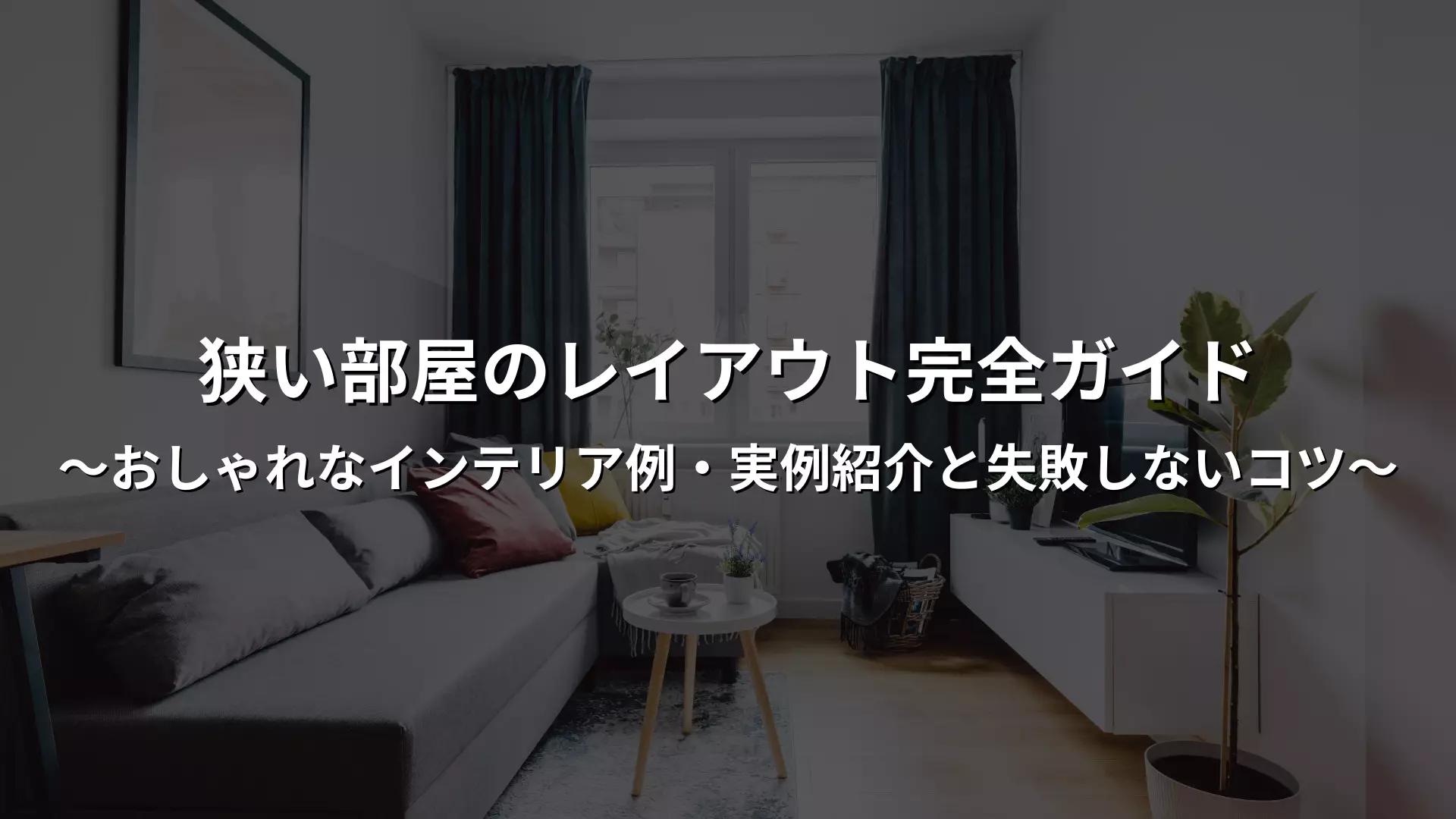Typical layout of a share house
Share houses come in a variety of layouts, but the types of share houses that are spreading across the country can be broadly categorized into the following four types. It is important to understand the characteristics of each and choose a layout that best suits your lifestyle and how you can manage your living expenses.
Shared space and rooms on the same floor
This type of share house is designed for room sharing, with shared spaces such as the living room and kitchen and each resident's room located on the same floor.
The advantage of this is that residents will be able to spend more time together, which makes it easier to communicate with each other. Therefore, it is ideal for people who want to enjoy interacting with other residents.
However, rooms close to the living room or kitchen can be noisy and it can be difficult to maintain privacy, so if you want to spend your time quietly, it's best to choose a room far away from the shared spaces.
A maisonette type with a shared space on the first floor and a room on the second floor.
This type of floor plan has shared spaces such as a living room, kitchen, and dining room on the first floor, and private rooms for two or more residents on the second floor.
The shared spaces and living rooms are clearly separated, making it easy to secure private space, and the advantage is that residents with different lifestyles can live comfortably together.
However, if the toilet or washing machine is located on the first floor, it may be inconvenient to move around when using them at night. Therefore, it is important to check the location of the facilities in advance while thinking about how to deal with such disadvantages.
Split floor for large groups
This type of share house is often found in large properties across the country, and is characterized by residents being separated on each floor.
For example, there are cases where the shared space and some of the rooms are on the first floor, and each resident's private room is on the second and third floors. Additionally, there are often kitchens and bathrooms on each floor, providing the convenience that only a large share house can offer.
On the other hand, if there are a lot of residents, the rules for using the common spaces may not be followed, which can lead to problems when moving out. If you choose a property with solid support from a property management company, you can live with peace of mind.
One-room conversion share house
This type of building was originally a one-room apartment or condominium and has been renovated to become a shared house.
In some cases, private rooms are equipped with a mini kitchen and toilet, making it easier to ensure privacy while reducing the disadvantages of room sharing.
However, since these properties were not originally designed as share houses, the common areas may lack facilities. It is important to check the facilities before signing a contract and determine whether the environment will be comfortable for you.
Tips for choosing a share house layout
When choosing a share house, the layout is an important factor that will determine how comfortable your life will be. By checking not only the rent and location, but also the type of room, layout of the shared spaces, and the level of facilities, you can achieve a less stressful life. Here, we will explain the points you should check when choosing a share house layout.
Room type (private room, dormitory, semi-private room)
Share house rooms can be broadly divided into three types: private rooms, dormitories, and semi-private rooms. Understand the characteristics of each and choose the one that best suits your lifestyle.
Private room
Private rooms are ideal for people who value privacy. Once you close the door, you are completely alone, making it easier to concentrate on work or study, and less likely to be affected by other residents with different lifestyles. However, rent tends to be a little higher than other types of apartments.
Dormitory (shared room)
Dormitories are rooms shared by multiple people and are suitable for people who want to keep costs down or who prefer a lively environment. In share houses, which emphasize international exchange, you may be able to enjoy communal living with foreigners. However, there is little privacy, so you will need to be mindful of noise and differences in daily rhythms.
Semi-private room
A semi-private room is a space separated by curtains or partitions, and although it is not a completely private room, it does provide more privacy than a dormitory. The rent is cheaper than a private room, and you can maintain a certain level of privacy, so it is recommended for people who value the balance between cost and privacy.
Distance and arrangement of shared spaces
In a share house, the layout of shared spaces such as the living room, kitchen, bathroom, and toilet will greatly affect how comfortable your life will be. Check where your room is located and consider the following points.
Rooms close to the common areas
Having a common space nearby is convenient because you can easily access a place to eat and socialize, but on the other hand, noise can be a concern. Rooms next to the living room or kitchen in particular are not suitable for people who want a quiet place to stay, as conversations and cooking sounds can echo into the night.
A room away from the common areas
The advantage of a room away from the shared space is that it is quiet and it is easier to have private time. However, if the toilet or kitchen is far away, it may be inconvenient to use them at night, so be sure to consider the distance that suits your lifestyle.
Room size and storage space
In a shared house, the size of rooms is often limited, so having storage space is important. Check the following points:
Room size
If you have a private room of 6 tatami mats or more, you can put in a bed and desk and still be reasonably comfortable. On the other hand, if you have a small room of 4 to 5 tatami mats, you will need to be creative in storing your belongings, so it is more suitable for minimalists.
Storage space available
Make sure there is a closet or storage shelf. If there is no storage space, you will need to prepare your own storage furniture, so it is important to think about the layout of the room in advance.
How to manage your luggage
Shared houses may have shared storage spaces, so it's a good idea to check whether you can secure your own storage space, especially in common areas such as the kitchen and bathroom.
Configuration and number of bathrooms and toilets
The number and placement of bathrooms and toilets are important points that directly affect the comfort of life in a share house. Make sure that the facilities are sufficient for the number of residents.
Number of residents and number of bathrooms and toilets
Generally, it is considered ideal to have one bathroom and toilet for every five people. If more than that number of people share one facility, it can be inconvenient as people tend to use it at the same time in the morning and evening.
Are the bathroom and toilet separate?
If the bathroom and toilet are in the same space, you will have the problem of not being able to use the toilet while someone is showering. Separate units make life less stressful.
Cleaning frequency and management system
Another important checkpoint is whether the bathroom and toilet are kept clean. Make sure to check in advance whether they are cleaned regularly and whether cleaning rules have been established between the residents.
Is the property designed for a shared house?
There are two types of share houses: those that are regular houses or apartments that have been renovated, and those that are designed as share houses from the start. It is important to note that the type of share house you choose can make a big difference in how easy it is to live there.
Features of properties designed for share houses
- Each room is soundproofed
- The shared space is spacious, allowing residents to move around easily.
- Adequate number of toilets and bathrooms
- Plenty of shared storage space
Points to note when renovating a property
- Because they were originally used as houses or apartments, the layout can be a little awkward.
- The soundproofing is poor, so it is easy to be bothered by noise from neighboring rooms.
- Shared spaces can be small and inconvenient
Properties that are specifically designed as share houses are often designed to make residents comfortable, so they are recommended for people who want to live a less stressful life.
Search for a room
Only furnished properties with appliances are listed!
Recommended floor plans based on number of residents
When choosing a share house, it is important to choose a floor plan that is appropriate for the number of residents. If there are only a few residents, the benefits of communal living will be diminished, while if there are too many residents, privacy and ease of use of facilities may be affected. Here we will explain the recommended floor plans for 2-3 people, 4-6 people, and 10 or more people.
Floor plan for 2-3 people
Share houses, where two or three people live together, are often shared with family or friends, and are characterized by the fact that it is relatively easy to maintain privacy. The typical layout of these houses is as follows:
Share 2LDK to 3LDK apartments and houses
- Each resident has their own room and shares a living room, kitchen, and bathroom.
- In many cases, the floor plan for a family is used as is.
The shared space is compact
- Even if the living/dining room is small, it still functions well.
- Since there is only one toilet and bathroom, it is easy to manage.
Easy communication between residents
- Because the number of participants is small, it is easy to adjust and discuss rules.
- Having similar lifestyles can lead to less stress and more comfort.
Recommended People
- People who wish to share an apartment with friends or couples.
- People who want to live in a relatively quiet and peaceful environment.
- People who want to value their private time while also enjoying the benefits of shared living.
This type of share house is ideal for people who are thinking of living together with friends or couples, people who want to live in a quiet and peaceful environment, and people who want to enjoy moderate social interaction while still having some private time.
Floor plan for 4 to 6 people
In a share house with 4 to 6 people, the residents will have more interaction with each other and it will have a more share house atmosphere. How to use the facilities and creating rules will become more important, so choosing the layout of the house will directly affect your comfort.
There are many detached houses and maisonette-type properties.
- In properties with two or more floors, the first floor is often the shared space and the second floor and above are the living areas.
- The living room is spacious, creating an environment where residents can easily gather together.
Having two or more toilets or bathrooms is convenient
- As the number of residents increases, it is likely that bathrooms and toilets will be used at the same time in the morning and evening, so we recommend a property with multiple bathrooms and toilets.
- Having a separate toilet and bathroom makes life easier.
Storage space and kitchen facilities are important
- When there are many residents, the amount of stuff increases, so it is convenient to have individual storage space and a shared pantry.
- Having two refrigerators makes it easier to secure space for storing food.
This type of share house is suitable for people who want to enjoy a moderate amount of interaction, who want to feel the community that only a share house can provide, and who can cooperate and live while following the rules regarding shared spaces and bathrooms.
Floor plan for 10 or more people
Large-scale share houses with 10 or more people require an environment where people can enjoy communal living as part of a community while still protecting their individual privacy. For this reason, careful consideration of the floor plan becomes all the more important.
Large shared space
- The shared living and dining areas are spacious and designed to make it easy for residents to gather together.
- Some properties also come with workspaces and lounges, making them ideal for residents who work remotely.
In many cases, the rooms are divided into floors.
- Typically, the first floor is the shared space and the second floor and above are the living areas.
- By locating bathrooms and toilets on each floor, congestion is reduced.
Easy to secure private space
- Because there are many residents, having private rooms with good soundproofing makes it comfortable.
- Even in dormitory-style rooms, the spaces are often separated by curtains or partitions.
The facilities are designed for shared houses.
- There are multiple bathrooms and toilets, making it easy to avoid crowds in the mornings and evenings.
- There is a large shared kitchen, allowing residents to enjoy cooking together.
This type of share house is suitable for people who want to actively enjoy the interactions of others in a share house, who want to interact with people with diverse values, and who want to live in an urban area at a reasonable rent.
Things to check before choosing a share house other than the floor plan
When choosing a share house, not only the layout but also the environment and facilities for a comfortable life are important. By checking the cleanliness, soundproofing, security measures, etc. of the shared spaces in advance, you can prevent stress once you start living there. Here, we will explain points other than the layout that you should check when viewing the house.

Cleanliness and usability of shared spaces
In a shared house, it is very important that shared spaces such as the kitchen, living room, and bathroom can be used comfortably. First, make sure that cleaning is done regularly. If there are cleaning rules set by the management company or residents, you should also check how often they are done. In addition, the storage space in the kitchen, the capacity of the refrigerator, and the ease of use of cooking utensils are also important. Don't forget to check that there are enough bathrooms and toilets for the number of residents, and that they are well ventilated.
Soundproofing and sunlight in the rooms
Since multiple residents live in a shared house, if the soundproofing of the rooms is poor, noise from neighboring rooms and common areas can be a concern and stressful. If the walls are thin or the rooms are close to each other, it is important to be careful as conversations and everyday sounds can easily echo. When viewing the property, it is a good idea to check how sounds echo with the door closed. Good sunlight and ventilation are also important. Check the position and size of the windows, the direction of the room, and make sure there is enough natural light and good ventilation to ensure a comfortable living environment.
Security equipment and management system
Since many people come and go in a share house, it is important to check in advance whether the environment is safe to live in. First, check the security measures at the entrance. Points to check include whether there is an autolock, security cameras, and whether private rooms have locks. It is also a good idea to ask in advance how the management company or owner ensures the safety of residents and how they will respond if trouble occurs. In particular, if it is a women-only share house, be sure to check whether the crime prevention measures are solid.
Search for a room
Only furnished properties with appliances are listed!
summary
Choosing the right layout for your share house is important for a comfortable communal life. By choosing a layout that suits the number of residents and their lifestyles, you can reduce stress and live comfortably. Common layouts include those where the shared space and living rooms are on the same floor, maisonette types, and floor-divided types for large groups. In addition, you should check the number of storage spaces, bathrooms and toilets, soundproofing, sunlight, and security. Be sure to check these when viewing the house and choose the share house that's best for you.































